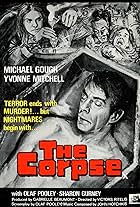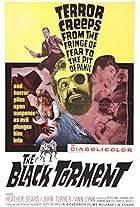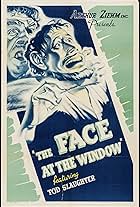A handsome tourist travelling through the desert comes upon a lavish Moorish castle wherein he is entertained by a mysterious wealthy woman.A handsome tourist travelling through the desert comes upon a lavish Moorish castle wherein he is entertained by a mysterious wealthy woman.A handsome tourist travelling through the desert comes upon a lavish Moorish castle wherein he is entertained by a mysterious wealthy woman.
Peter Evans
- Pallbearer
- (uncredited)
George Holdcroft
- Pallbearer
- (uncredited)
Pat Judge
- Party Guest
- (uncredited)
John Lynn
- Party Guest
- (uncredited)
Guy Standeven
- Pallbearer
- (uncredited)
- Director
- Writer
- All cast & crew
- Production, box office & more at IMDbPro
Featured reviews
"The Hand of Night" (British title) was actually scripted as a vampire film 'without blood,' an effective mood piece, featuring American veteran of British horrors such as "Gorgo," "Devil Doll," and "Devils of Darkness," William Sylvester starring as architect Paul Carver, tortured for two months by the loss of his wife and family in a car crash, whose seeming death wish finds him bedazzled by the denizens of the dark in present day Morocco (in other words, what if the Mummy was a vampire?). These fangless vampires are unaffected by Christian symbols like the cross, fearing only the light, feeding not upon blood but upon life itself, not unlike those in "Captain Kronos: Vampire Hunter" (they still cast no reflection). Revived by the recent excavation of her long buried tomb, 14th century princess Marisa was the most cherished prize in her husband's harem, buried alive for her faithlessness, but not before pronouncing a fateful curse, explained by archaeologist Leclerc (William Dexter): "here lies one who does not sleep, but walks the night of death to make all mankind her slave." A curiously passionless performance from Alizia Gur, beautiful former Miss Israel in 1960, one of the two fighting gypsy girls in 1963's "From Russia with Love" (the girl in blue was Martine Beswicke). Miss Gur's career petered out in the early 70s while blonde heroine Diane Clare apparently threw in the towel even earlier. Miss Clare had her share of genre titles, ranging from "The Naked Edge" (Peter Cushing), "The Haunting," "Witchcraft" (Lon Chaney), "The Plague of the Zombies," and "The Vulture" (this was her final feature). Diane has the lines that inspired the original title: "to reach out the hand from dying day, is to clutch the hand of night" (as unsuccessful in Britain under that title as in the US release under "Beast of Morocco"). Like Diane Clare, Edward Underdown was a guest star on THE AVENGERS, and played in the 1965 James Bond feature "Thunderball." Veteran British player Terence de Marney, who had appeared with both Lugosi (1935's "The Mystery of the Marie Celeste") and Karloff (1965's "Die, Monster, Die!"), sparks the proceedings as vampire servant Omar, whose demise at sunrise is by far the standout sequence, as seen in the picture's ads. This marked the climax of William Sylvester's starring career, moving on to Kubrick's "2001: A Space Odyssey," 1973's TV chiller "Don't Be Afraid of the Dark," and his final feature role as a TV interviewer in 1980's "First Family" ("nearly 30 million Americans actually voted for the two corpses!"). Becoming ever more obscure over the decades, "Beast of Morocco" made three appearances on Pittsburgh's Chiller Theater, Apr 11 1970 (preceded by 1959's "The Purple Gang"), Apr 3 1971 (followed by 1966's "Curse of the Swamp Creature"), and May 20 1972 (followed by 1958's Mexican title "The Black Pit of Dr. M").
Flatly directed would-be horror movie, consisting of long scenes of frequently stilted dialogue interspersed with garish dream sequences. Frederic Goode is one of the most obscure of all British film directors, and on this showing that's no surprise. He fails to bring any conviction to the film at all, and of the actors only veteran Edward Underdown emerges with any dignity. Even the usually dependable William Sylvester, who seems to have been sprayed with orange dye, is defeated by a script that persists in drivelling on about light and darkness to little effect. Filmed in 1966, this sat on the shelf for a couple of years, and makes for terminally tedious viewing.
William Sylvester (Carver) blames himself for the death of his wife and children in a car accident and has given up with life. He goes to Morocco to hopefully recuperate but he seems to have gained access to the ethereal world that is ruled by Aliza Gurr (Marisa), a dead princess who has put a curse on men she encounters as she wanders around at night-time.
It's not a particularly good film but it does hold an interest because of the different feel to it - it is set in Morocco with spacious vistas to take in and the storyline involves vampires in the desert.
The cast are not particularly wonderful. Apart from Sylvester and Gurr, only Terence De Marney (Omar), who plays a vampire henchman, does not attempt an accent. However, this very obviously looking Brit does not convince as an arab. As for the others in the cast, Diane Clare (Chantal) clearly can't act and is the worst offender when it comes to failing with an accent - it's really quite annoying.
Still, the film scores for being different - those poor gypsy belly-dancers!
It's not a particularly good film but it does hold an interest because of the different feel to it - it is set in Morocco with spacious vistas to take in and the storyline involves vampires in the desert.
The cast are not particularly wonderful. Apart from Sylvester and Gurr, only Terence De Marney (Omar), who plays a vampire henchman, does not attempt an accent. However, this very obviously looking Brit does not convince as an arab. As for the others in the cast, Diane Clare (Chantal) clearly can't act and is the worst offender when it comes to failing with an accent - it's really quite annoying.
Still, the film scores for being different - those poor gypsy belly-dancers!
A tinny, amateurish quickie with a lot of obviously post-synced sound which doubtless provided the interesting cast (most of them Brits struggling with a variety of 'foreign' accents) with a holiday on expenses in Morocco; the 'action' organised around what locations were available, dream sequences absolving the makers of creating a coherent narrative, and the continuous use of zooms enabling director Frederic Goode to quickly get scenes in the can so they could all pack up and go home.
Never heard of this minor British horror before, then it turned up on late night TV.
It opens up interestingly enough - our main character (played by William Sylvester) is in a foggy graveyard, with a funeral in progress. Next he's in the crypt, so too are a bride & groom, some bats and skeletons. This is all very cheap and cheesy looking, it turns out to be a nightmare. Sadly this early promise is scuttled, the majority of the film is rather boring, has bad acting (some very unconvincing foreign accents), blatant day for night scenes,weak continuity and not much horror. The vampires here don't appear to have fangs, I don't remember seeing much, if any, blood and there is too much waffle about the light and the darkness (good and evil). The print that was screened was of poor quality so that didn't help. Some great scenes of the Moroccan desert though.
I do love British horror, especially from this period, but this was sadly rather poor.
Storyline
Did you know
- TriviaFinal acting role of Diane Clare.
- Quotes
Chantal: Did you kill them?
Paul Carver: That's a pretty brutal question to ask, don't you think?
Chantal: Life's a brutal business. Belsen, Hiroshima... they say the good's getting better, but that could mean the bad is getting worse, too.
- ConnectionsFeatured in Scream-In: Beast of Morocco (1968)
- How long is Beast of Morocco?Powered by Alexa
Details
- Runtime1 hour 30 minutes
- Sound mix
- Aspect ratio
- 1.37 : 1
Contribute to this page
Suggest an edit or add missing content






















